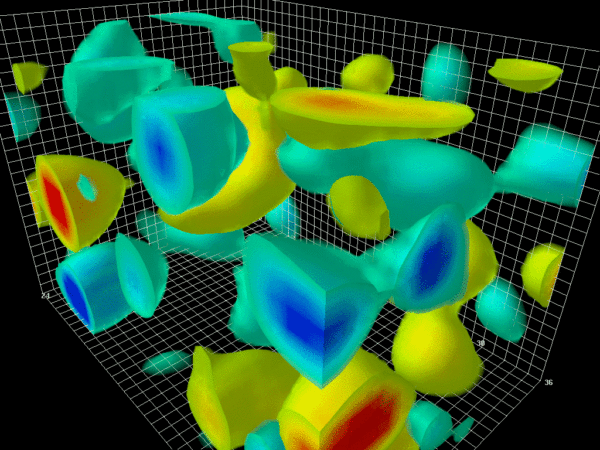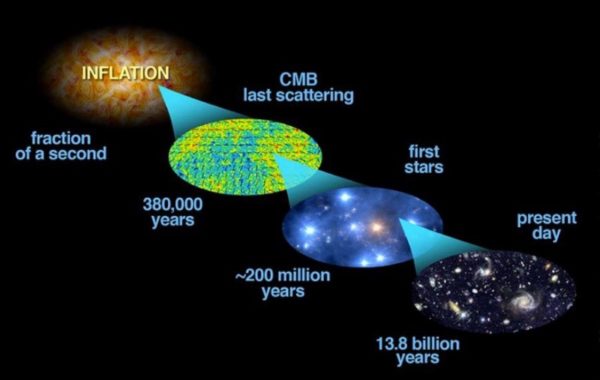“Alone, I often fall down into nothingness. I must push my foot stealthily lest I should fall off the edge of the world into nothingness. I have to bang my head against some hard door to call myself back to the body.” -Virginia Woolf
If you think about the Universe, what it is today, what it contains and what makes it up, it very much is “something” by any way you’ll attempt to define it. Yet every “something” we know of has an origin, and the only ultimate origin for the first “something” is that it must have come from nothing.
 Visualization of a quantum field theory calculation showing virtual particles in the quantum vacuum. Image credit: Derek Leinweber.
Visualization of a quantum field theory calculation showing virtual particles in the quantum vacuum. Image credit: Derek Leinweber.
Yet what do we mean, as physicists, when we talk about nothing? Do we mean empty space; do we mean the quantum vacuum; do we mean the nothingness of our Universe or the Multiverse; do we mean the state from which space and time and the laws of physics first arose? Physicists and philosophers don’t necessarily have a good answer to this, yet that doesn’t mean we don’t have intelligent things about the different types of nothingness to talk about!
 The hot Big Bang resulted from the end of cosmological inflation. But that still required the existence of space, time, and a large zero-point energy. Where did all of *that* come from? Image credit: Bock et al. (2006, astro-ph/0604101); modifications by E. Siegel.
The hot Big Bang resulted from the end of cosmological inflation. But that still required the existence of space, time, and a large zero-point energy. Where did all of *that* come from? Image credit: Bock et al. (2006, astro-ph/0604101); modifications by E. Siegel.

I thought Krauss did a decent job in his book, covering the subject of the different definitions and the answer to the question 'can something come from nothing' for each definition. I know a lot of philosophers pooh-pooh him (and there's probably no love lost on his side), but his treatment seemed very even-handed to me.
I give the book a spontaneously generated ex nihilo thumb up.
Another way to regard nothing is that it is the potential for everything. The closer one comes to nothing, the more potential there is for something (or more things).
On the particle physics side, taking the quantum vacuum as the defined "nothing," as a layman and despite reading as much here as I can, I have a difficult time grasping the underpinnings of the notion of virtual particles popping in and out of existence in this quantum vacuum. Yet all the physicists seem so certain of that basic concept, essentially that nature abhors a vacuum. It seems to me related to this idea of potentiality of nothingness, but I can't see how it goes from merely idea to actual theory.
nice article. One solution to avoid confusion, is to simply drop the word nothingness. Krauss did a good job in explaining how we don't need anything else than what we have inherently in spacetime.. but keeps calling that "nothingness". Just like Ethan in the article... nothingness is just spacetime without any matter and energy. But that's something. :) It's space with nothing in it.. but there's still space and energy inherent to it.
Nothingness is nothingness.. no anything. And you can't do physics with that. So stop using the word, no matter how catchy it sounds. Call things for what they are... empty space.. quantum vacuum... they all mean something, and are something.
So a instead of saying from nothing something... we should really be saying.. there is/was always something... it needn't have been matter... but it sure wasn't nothing :)
This is not exactly my subject but I'll give it a try. More experienced physicists, feel free to correct my ramblings.
Its useful to think in terms of wavefunctions. Let's take something easier, like an electron circling a proton. It has wavefunction. That wavefunction has many different solutions to it. Each solution is some place the electron "could be." If you're familiar with QM, you know that the probability of finding that electron somewhere specific is equal to the square of the value of its wavefunction at that location. Wherever the wavefunction has a nonzero value, you will eventually find the electron there. If the value of the wavefunction for those coordinates is very small, you might statistically have to wait longer than the duration of the universe. But ignoring those cases, for reasonably sized solutions, its going to happen. 'Statistically guaranteed,' so to speak, because the probability of it never being in some allowed place is some fraction lower than one, taken to the Nth power, were N is the very very large number of time increments the system experiences over a human-scale time period.
Got all that? Good.
Okay, so "empty space" also obeys quantum mechanics. It can be described in wave function terms. That wave function has many solutions. Some of the solutions with reasonably-sized values are "particle-antiparticle pair found here." So if you watch the space long enough, you're going to see that solution occur. Statistically guaranteed, so to speak. To not see it happen would be like flipping a coin every femtosecond and never getting heads.
To add to what Eric has said, I recall a bit from A Brief History of Time, where Stephen Hawking explains about the concept of Hawking radiation. He says that what we think of as empty space cannot really be so empty, because that would be a violation of the Heisenberg Uncertainty Principle. The value of a field and its rate of change are like the position and momentum of a particle in the Uncertainty Principle, so space cannot be completely and utterly empty of all fields, since that would mean that the values of all fields would have a definite value (0) and definite rates of change (also 0). There is always a certain amount of fluctuation even in completely empty space. That means what we think of empty space is really full of virtual particle/antiparticle pairs that pop into and out of existence so rapidly that they normally can't be observed directly. Near a black hole's event horizon though, one particle of such a virtual pair can find itself past the event horizon, falling into the hole, while the other one remains beyond. To an observer far away from the black hole, it will look as though the black hole emitted a particle. To satisfy conservation of energy the particle that fell into the hole must be considered to have negative energy, and the black hole loses mass as a result.
As an aside, if you understood my first paragraph then you also now understand how nuclear decay happens. Just think "protons in a nucleus" rather than "electron orbiting a proton." That proton (or other bit of the nucleus) has a wavefunction. If the value of that wavefunction is significantly non-zero at locations outside the nucleus itself, that proton will occasionally be found outside the nucleus. High wavefunction value at outside locations = high probability of that solution occurring = short half-life. Low value = long half-life. Zero value = stable atom.
Though I should point out that the math is often insanely complicated. The half-lives you see on the periodic table and in books are empirically determined values, not values calculated from QM.
@eric (#6): Well, generally what would actually appear outside the nucleus (quantum tunnelling) would generally be an alpha particle, rather than a single proton, because the very high binding energy of the alpha particle (helium nucleus) means that it actually costs less energy for an unstable nucleus to emit one rather than a single proton.
Actually, the maths here are not as complicated as you think. Even if you attempt an elementary solution using only the Schrödinger equation and a relatively simple approximation of the potential well of an atomic nucleus to try to compute alpha decay half lives, you can actually get results that are already in reasonably close agreement with the observed half lives of alpha particle radioisotopes. The maths here are not so insanely complicated as you seem to think, probably only at the level of undergraduate calculus, and more advanced treatments do not improve on the results so substantially.
I once ran across a quantum mechanics text that described the wave function as giving the probability amplitude of the particle materialising at that position.
It doesn't explain all types of nuclear decay though. There is the phenomenon of beta decay, where a nucleus emits an electron or positron. That was an absolutely bizarre phenomenon that led to the discovery of neutrinos and the weak interaction.
My issue with the question why there's something instead of nothing (the philosophical "true nothing") is that it assumes "nothing" is a valid state, as though "something" and "nothing" are just flip sides of the same coin. Like Ethan mentions in his article, I'm not convinced that's it's even meaningful, since a state is, itself, arguably "something".
Yes, I'm just flinging words around by saying that, philosophizing by dictionary definition, but I believe that's also true of those I disagree with. It's easy to toss around words.
It's far more interesting to discuss the properties of physical "nothing", though I agree with Sinisa that it's a bad name for it.
<Madhyamaka>Where were you before you were born?</Madhyamaka>
"I have a difficult time grasping the underpinnings of the notion of virtual particles popping in and out of existence"
It's as simple as:
a) We can't say there's no energy there, since that's a certainty and we can't have certainty in quantum mechanics
b) Mass and energy are interchangeable
c) Therefore there can be matter there for a short enough time that it's less than the uncertainty in energy in that volume
d) Therefore there's matter there, but not long enough to break the uncertainty principle
These are virtual particles, or the quantum foam.
Nothingness is based on the paradox of being and not being where matter as a contradiction of itself comes to that point where it is and isn,t at6the same time , sort of like caving in and expanding at point zero precise.
Thanks, Gary. That cleared it all up.